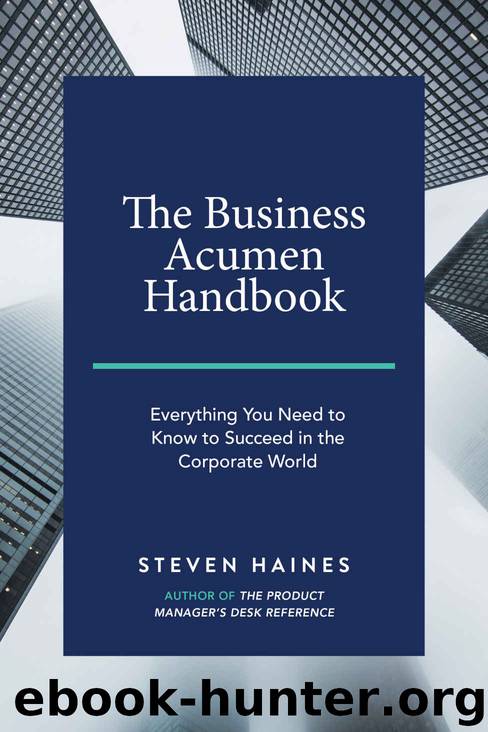The Business Acumen Handbook: Everything You Need to Know to Succeed in the Corporate World by Steven Haines

Author:Steven Haines [Haines, Steven]
Language: eng
Format: epub
Publisher: Business Acumen Institute
Published: 2019-02-04T05:00:00+00:00
Consumer markets are those made up of people like you and me who buy food, houses, clothes, gadgets, and the like. Business markets are made up of businesses of all types in one or more locations. Businesses purchase goods and services so they can ultimately make products to sell to consumers or to other businesses. In the jargon of business, companies that sell to consumers are known as business-to-consumer (B2C) firms. Businesses that sell to other businesses are business-to-business (B2B) firms. B2B companies sell their products to businesses that then sell to customers, other businesses, or even government agencies. One of the important common denominators is that businesses are not people per se, but they are referred to in their entirety as customers and personified. The reason is that different types of people work in businesses: users, purchasers, decision makers, and influencers. The same can be said of a consumer household. The main point I want to make is this: If you know who the desired target customers are, regardless of where they reside or work, you will have a better chance to understand what motivates them and to target products or solutions toward their needs.
The other area I want to discuss involves the expression customer needs as it relates to what actually triggers, or motivates, a customer to act. Have you ever watched a television advertisement with an announcer saying something about meeting your unique needs? Or has a salesperson ever asked you, “What keeps you up at night?” These broad assertions or selling techniques may miss the mark because they don’t take into account the true definition of the word need and the fact that customer needs, for the most part, are transient. Even with needs that come and go, astute business people know that by considering the habits and cadences of customers, they can induce a motivation to act.
A manufacturing business that requires a steady stream of parts to make products is satisfied when its suppliers provide the right number of parts at the right time at the right price. (Note that the company is now personified because the business overall has a need.) However, one interruption in the supply chain will magnify the need significantly, with workers idle and orders unfilled. Consumer needs, on the other hand, exhibit themselves frequently: hunger, warmth, safety, and so forth.
One last point on the term needs: I recently spoke with a category manager who worked for a global importer and distributor of alcoholic beverages. My goal was to learn about how his company’s market research programs characterized customers and sized its markets. I asked if he had a model that mapped out market segments and customer targets. Although he described the demographic profiles, he also said that in his business, marketers weren’t permitted to use the word needs due to its implications and the markets on which they focused. He said they use the term motivational state. My eyes lit up—motivational state! That’s a term that I can get my
Download
This site does not store any files on its server. We only index and link to content provided by other sites. Please contact the content providers to delete copyright contents if any and email us, we'll remove relevant links or contents immediately.
Hit Refresh by Satya Nadella(8330)
The Compound Effect by Darren Hardy(7545)
Change Your Questions, Change Your Life by Marilee Adams(6637)
Nudge - Improving Decisions about Health, Wealth, and Happiness by Thaler Sunstein(6629)
The Black Swan by Nassim Nicholas Taleb(6184)
Daring Greatly by Brene Brown(5636)
Deep Work by Cal Newport(5452)
Principles: Life and Work by Ray Dalio(5315)
Rich Dad Poor Dad by Robert T. Kiyosaki(5140)
The Myth of the Strong Leader by Archie Brown(4785)
Man-made Catastrophes and Risk Information Concealment by Dmitry Chernov & Didier Sornette(4728)
Big Magic: Creative Living Beyond Fear by Elizabeth Gilbert(4718)
The Slight Edge by Jeff Olson(4716)
Discipline Equals Freedom by Jocko Willink(4631)
The Motivation Myth by Jeff Haden(4521)
Digital Minimalism by Cal Newport;(4511)
Stone's Rules by Roger Stone(4412)
Management Strategies for the Cloud Revolution: How Cloud Computing Is Transforming Business and Why You Can't Afford to Be Left Behind by Charles Babcock(4127)
The Doodle Revolution by Sunni Brown(4035)
